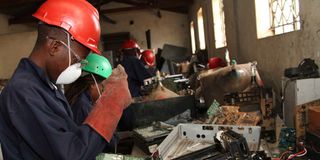The art of recycling used electronics to make the planet greener

Staff at the Waste Electrical and Electronics Equipment Centre dismember a computer.
What you need to know:
- E-waste refers to electronic products that are unwanted, not working, and nearing or at the end of their useful life.
- They include computers, laptops, mobile phones and other home appliances such as televisions and fridges.
The rapid technological boom has resulted in a huge increase in discarded electronic equipment, leading to a global e-waste crisis. E-waste refers to electronic products that are unwanted, not working, and nearing or at the end of their useful life. They include computers, laptops, mobile phones and other home appliances such as televisions and fridges.
A record 53.6 million metric tonnes (Mt) of e-waste was generated around the world in 2019, and this number is on the rise. That, according to data from the United Nations Environment Programme (UNEP) and partners, is equivalent to seven kilogrammes for every person on earth; a number predicted to double by 2050 if nothing is done.
This is what inspired Boniface Mbithi to start the Waste Electrical and Electronics Equipment Centre (WEEE), an electronic waste recycling company that has been playing a part in reducing e-waste, albeit in small yet effective ways. Located in Mihango, Nairobi County, WEEE centre has been collecting and recycling a variety of electronic waste, including damaged computers, solar panels, home electronics and mobile phone accessories from over 100 collection centres in Kenya.
The processing procedure at the centre includes collection, transportation, pre-sorting, inventory, refurbishment, reuse, dismantling, separation and recovery or recycling. “The e-waste that is in good condition is usually repaired and channeled to the charity wing of our centre, where they are donated to educational training institutions, youth and women groups and community information access and resource centres,” explains Joseph Oliech, project manager at WEEE Centre.

Joseph Oliech, project manager at Waste Electrical and Electronic Equipment Centre during the interview in Utawala on July 18.
The ones that are beyond repair, according to Oliech, are dismantled and then all fractions from the e-waste items like plastic, cables, metal, motherboards and batteries retrieved. Also, hazardous substances such as mercury, lead and flame retardants that are frequently found in electronics are safely removed. Items that cannot be recycled are exported to countries in Europe with more advanced e-waste handling and disposal techniques.
“We have some fractions that are problematic to handle locally such as motherboards. We do not have a facility to handle such fractions in Africa therefore we have partnered with recycling facilities in Europe for final treatment and recovery of rare elements in such fractions,” explains Oliech. The company also handles and stores hazardous materials such as batteries.
“This is aimed at reducing the number of batteries being disposed of as material waste. Batteries contain several poisonous chemicals and heavy metals and their dumping has attracted environmental concerns due to contamination of water and soil.” The centre also runs a plastic shredder that crushes all forms of plastic collected or separated from e-waste. Pellets from crushed plastics are used to manufacture plastic fencing posts and worktops.
Since 2007, the firm has handled over 5,000 tonnes of e-waste from more than 800 companies and individuals in Uganda, Tanzania and Rwanda. In Kenya, only one per cent of the 51.3 metric tons of e-waste generated every year is recycled. Globally, 20 per cent is recycled, and according to UNEP, the rest is dumped, often to be sifted through in low-income countries by informal workers, including children, seeking to extract valuable materials at grave risk to their health.
According to Kevin Lunzalu, a marine ecologist, the dangers of e-waste are becoming more pronounced in this modern era where people are more dependent on advanced technology than ever before. “E-waste does not easily break down, hence, increased improper disposal of the materials causes immense risk to the environment and human health.”
Studies have shown how indicators of increased exposure to large amounts of contaminants from e-waste are currently manifested through diseases such as cancer.
But other than the health implications, e-waste has become a challenge to the environment. “Productivity of soil is diminishing; water is becoming unsafe for consumption and humans, plants, and animals are ingesting heavy metals such as lead, cadmium, thallium, arsenic and beryllium through contaminated food and water,” explains Lunzalu.
According to experts, the influx of e-waste is largely attributed to the lack of proper recycling infrastructure and legislation in most parts of the world, and in all this, Africa will suffer the most. With an absence of robust laws to address the problem, Africa has become a dumping ground for electronic waste from the developed world.
Regionally, as of July 2022, the East African Community prohibited the importation of cathode rays tubes (CRTs) and standalone used computer monitors. With the entry into force of its new regulation, vendors of electronic gadgets operating in the region, are now responsible for the disposal of waste generated by their products.
Here in Kenya, the Government has also tried to curb the menace through laws and proposed legislation, such as the Sustainable Waste Management Act, 2022 and a draft Electronic Waste Bill in parliament that was formulated in 2013.
The Sustainable Waste Management Act establishes the legal framework for the sustainable management of waste. “This would ideally require electronics manufacturing companies operating in Kenya to take responsibility for the pollution of their products cause during their entire product life cycle,” explains Stella Ojango, an advocate of the High Court and an environmental lawyer.
The draft Electronic Waste Bill, on the other hand, was formulated in 2013, and it addressed pressing concerns regarding electronic waste management. “However, its lack of prioritisation and enforcement over the past years has hindered its efficacy in addressing the mounting e-waste challenges in the country that have not been solved by the Sustainable Waste Management Act,” adds Stella.
A 2023 report by European Training Foundation states that Kenya generates 51.3 metric tons of e-waste every year, with only 1% being recycled formally. The remaining 99 per cent of the generated e-waste ends up in dump sites and waterways causing soil, water, and air pollution which means that the act is far from being effective in managing e-waste in Kenya.
According to Stella, a critical gap emerges in the lack of enforcement and industry participation. This gap in implementation, she says, may be attributed to insufficient enforcement mechanisms within the Act, compounded by the absence of regulatory pressure on the electronics industry.
According to Stella, there needs to be a multi-sectoral approach to the implementation of e-waste management with the government taking a proactive approach in sensitizing the different players.





